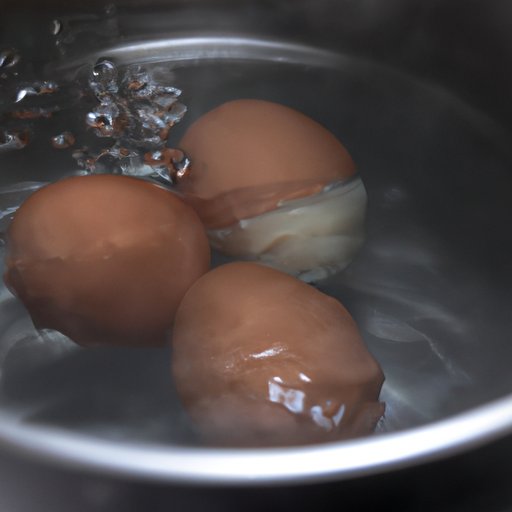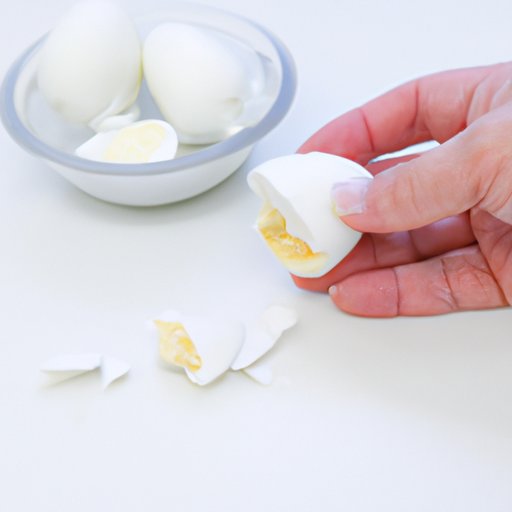

How to Hard Boil Eggs: Explore the Perfect Techniques
Hard boiled eggs are a staple food for many households. They are versatile, nutritious, and an excellent addition to many meals or snacks. However, many people often struggle with getting the eggs right and avoiding issues such as undercooked or overcooked eggs or tearing the egg whites. Don’t worry; in this article, we will explore various techniques for boiling eggs, offering tips and tricks to ensure you get it right every time.
The Classic Method: A Step-by-Step Guide to Perfectly Hard Boiling Eggs
The traditional method of hard boiling eggs is a simple approach that many people use. You start by placing the eggs in a pot, covering them with cold water, and then bringing the water to a boil. Once it boils, reduce the heat and let it simmer for a set time, depending on how you want your egg cooked.
Here is a step by step guide using the classic method for boiling eggs.
- Place the eggs in a pot and cover them with cold water.
- Place the pot on the stove and bring the water to a boil.
- Once the water starts to boil, reduce the heat to low and allow to simmer for 7-12 minutes depending on how you want your egg cooked. For a soft boiled egg, simmer for 7-8 minutes; for a medium boiled egg, simmer for 9-10 minutes and for a hard-boiled egg, simmer for 12 minutes.
- Remove the eggs from hot water immediately and transfer them to a bowl of ice water.
- Let them cool until they are comfortable enough to handle, and then peel the eggs.
Tips:
- Use older eggs as they are easier to peel compared to fresh eggs.
- Don’t crowd the eggs in the pot. If you add too many, you may end up overcooking some of them.
- Adding a tablespoon of vinegar to the water can help keep the eggs from cracking.
- Adding salt to the water can help to make peeling the eggs easier.
The Fool-proof Approach: Hard Boiling Eggs with Zero Guesswork
If you want a no-fail method for hard boiling eggs, then try this foolproof approach. This technique uses the cold egg-start method, which involves placing eggs in cold water and then heating them up gradually to avoid cracking or tearing the egg whites. The eggs come out perfectly cooked with no guesswork involved.
Here is a step-by-step guide for boiling eggs using this technique.
- Place the eggs in a saucepan and add enough cold water to cover the eggs fully.
- Place the pan on the stove over high heat and bring the water to a rolling boil.
- Turn off the heat, cover the pan with a lid, and let the eggs sit in the water for 10-12 minutes, depending on how you want your egg cooked.
- Remove the eggs from hot water immediately and transfer them to a bowl of ice water.
- Allow to cool so you can peel them.
Tips:
- Use eggs that are the same size for even cooking.
- Make sure you use a small saucepan to prevent the eggs from bumping against each other and cracking.
The Scientific Way: How to Hard Boil Eggs Using Temperature Control
The temperature control method is a new technique for boiling eggs that takes a scientific approach to cooking. This method involves use of a sous-vide machine or a kitchen thermometer to monitor and regulate the water temperature to the exact degree for precise cooking.
Here is a step-by-step guide for boiling eggs using temperature control.
- Fill a large pot with water, attach your sous-vide machine, and set the temperature to 147°F.
- Place the eggs in a zip-lock bag, ensuring that they are lying flat, and remove as much air as possible.
- Place the bag with the eggs in the pot of water.
- Let the eggs cook in the water for 45-90 minutes, depending on how you want them cooked.
- Remove the eggs from hot water immediately and transfer them to a bowl of ice water.
- Allow to cool so you can peel them.
Tips:
- Use eggs that are close to the same size for even cooking.
- Consistency is key with this method; ensure the pot you are using to boil the eggs is stable and maintains the desired temperature for even cooking.
The Asian Twist: Infusing Hard Boiled Eggs with Soy Sauce and Tea Leaves
This method of boiling eggs is inspired by the Asian cuisine and is an excellent way of adding an unusual and unique flavor to traditional boiled eggs. Soy sauce and tea leaves give the plain eggs a subtly sweet, salty umami flavor.
Here is a step-by-step guide for boiling eggs using this technique.
- Bring a pot of water to boil and add tea bags and a tablespoon of soy sauce.
- Lower 4-6 eggs and let them boil for 7 to 8 minutes, then remove them with a slotted spoon.
- Gently tap each egg and crack evenly, but do not separate the shell completely (ensure the egg is still completely covered with eggshell).
- Return the eggs to the pot of infused water and let them boil for another 7-8 minutes.
- Remove the eggs from hot water immediately, transfer them to a bowl of ice water, let them cool, and then peel them.
Tips:
- Use a pot that’s deep enough to submerge the eggs completely.
- If you prefer a stronger flavor, allow the eggs to sit in the infusion for longer before boiling.
The Instant Pot Method: Quickly Hard Boiling Eggs with Pressure Cooking
The Instant Pot method is a fast way to cook eggs with pressure cooking. It’s a quicker approach than other methods and simultaneously produces perfectly boiled eggs that peel off quickly with no mess.
Here is a step-by-step guide for boiling eggs using an Instant Pot.
- Pour one cup of water into the Instant Pot and add a trivet.
- Carefully place 6-8 eggs on the trivet.
- Cover the pot with a lid and turn on high pressure for 5-6 minutes.
- Once it’s finished, release the pressure manually and immediately transfer the eggs to a bowl of ice water.
- Let them cool down to room temperature so you can peel the eggs.
Tips:
- Use eggs that are close to the same size for even cooking.
- The timing in the Instant Pot method is critical; set a timer to ensure you get the correct cooking time.
The Sous Vide Approach: Mastering Hard Boiled Eggs with Precision Water Baths
The sous vide approach offers an advanced technique for hard boiling eggs using a precision water bath. This method produces eggs that are incredibly consistent in texture and don’t get overcooked.
Here is a step-by-step guide on boiling eggs using the sous vide technique.
- Fill a pot with water, attach your sous vide machine, and preheat the water to 145°F.
- Place the eggs in a ziplock bag, attach a weight to the bag to keep it from floating, and then place it into the hot water.
- Let the eggs cook in the water for 40-75 minutes, depending on how you want them cooked.
- Remove the eggs from hot water immediately, transfer them to a bowl of ice water, let them cool, and then peel them.
Tips:
- This method requires additional equipment such as a sous vide machine.
- This method takes longer than other boiling methods.
- Ensure your water doesn’t evaporate as it affects the cooking process.
The Baking Method: Making Hard Boiled Eggs in the Oven
This final method of hard boiling eggs involves using the oven, and it’s an excellent way to hard boil eggs in bulk.
Here is a step-by-step guide on how to boil eggs using the baking method.
- Preheat your oven at 325°F.
- Place eggs in a muffin tin (one egg per cup).
- Bake the eggs for 30 minutes, then remove them from the oven.
- Immediately transfer them to a bowl of ice water.
- Let them cool down to room temperature so you can peel the eggs.
Tips:
- Use the same size eggs for even cooking.
- Try using parchment cup liners to make cleaning easier.
Conclusion
Hard boiled eggs are a versatile food that can be a great addition to your diet. With the techniques we have explored above, you can easily boil eggs to the desired level of doneness. Remember to experiment with different methods to find out what works best for you. Finally, always use fresh eggs, and enjoy the boiled eggs’ many nutritional benefits.
Tips for peeling and storing hard boiled eggs:
- Peel under running water or in an ice bath to make peeling easier.
- Store boiled eggs in the refrigerator for up to five days.




